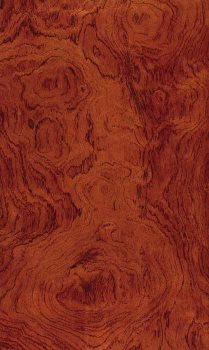Bubinga (Guiburtia, tessmanii)
Trade Names: Bubinga, Kevazingo
Origin: Africa
Range: West Africa, from East Nigeria through Gabon to Zaire, drier regions in the lower tropical rain forests. Trees up to 45 m tall with conspicuously high roots. Differentiation is made between plain striped and pommele Bubinga wood, latter of which is considered the most valuable at present.
Uses: Higher quality architectural woodwork and mass-produced furniture, paneling and parquet flooring. Well-suited also for musical instruments.
Properties: Brown to violet-red heartwood with conspicuous growth zones. Resin pockets can occur; these degrade both the veneer and lumber. To achieve the required grain Bubinga is either true quarter cut (rather plain) or rotary cut eccentrically (colorful). This specie has a wide array of figure types ranging from mottled to fiddleback, and pomele as well as an occasional cluster/burl.
Machining: Despite its great hardness this wood is relatively easy to work. However, carbide-tipped tools should be used.
Seasoning: The wood should be carefully and slowly dried to avoid splitting. When moist, the wood gets a blue stain when coming into contact with metal.
